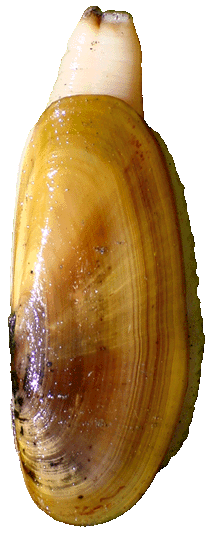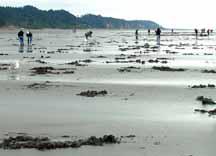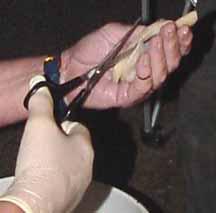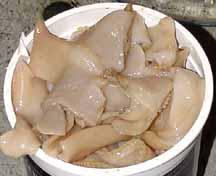Clam Digging
| Slide Show 1 | Slide Show 2 | Slide Show 3 |
 |
The almighty Pacific Razor Clam (Siliqua patula) is a tasty treat to thousands of people of the great Pacific Northwest and to those who are within driving distance to the Pacific Ocean beaches of Washington and Oregon State. Although the beaches are sometimes closed to the digging of these delectable bivalves, because of toxins the clams can absorb from algae, the beaches are normally open for a few days in the months of October through April. And, when the beaches are open to digging, they are filled with many thousands of people, at low tide, stalking the hidden prey.
 |
This is truly a family sport, and you will see people of all ages including children and senior citizens trying their hand at this. Under the rules of the Washington State Department of Fish and Wildlife, harvesters may take no more than 15 clams and must keep the first 15 taken (no matter what size, or condition), and diggers 15 years and older must have a valid license to participate.
 |
First, the job is to determine just where a clam is located and this is not always easy. You have to scan the surface of the sand carefully for the "clam show". These are the telltale signs the clam provides to let you know where he's buried. It's usually in the form of a dimple or small "key hole" in the sand, but you need to be aware that buried Sand Shrimp and Dungeness crab can also lead you astray. The shrimp are normally found higher up on the beach and if you come across one, you know that you need to head further toward the water. You will not normally come across a crab, but if you do, it will be buried only a few inches down. Some people use a technique of stamping their feet on the sand or pounding the sand with the handle end of their shovel as they walk along to make the clams give away their location. We, however, prefer not to do this as it gives the clam a warning that you are in the area and provides them with a head start in their journey downward to escape your grasp.
 |
Next, you need to know how to use your shovel or "clam gun". Many diggers use a specialized short handled shovel, but you must have a practiced technique to use it properly or you'll end up damaging the clams. You will also end up on your knees and sometimes have your whole arm in the sand reaching for your quarry. We prefer to use an elongated tube with handles that you push down into the sand. It is closed at the top end except for a thumb hole which you cover when you are ready to suck up the sand with the clam as you pull with all your might to get it up and out. To use the tube, you face the ocean and center the open end of the tube over the "clam show", with the top end angled slightly toward you. Then you just push the tube down hard into the sand, wriggling it slightly from side to side to loosen the sand to get it to slide further down. You then put your thumb over the hole in the closed end to allow suction to hold the sand as you pull out the tube. Then you remove your thumb and shake out the core of sand and investigate the core for the clam. You may have to plant your tube back in the hole two or three times before your quarry is caught. There is nothing easy about this, and you'll need to be careful not to hurt your back, but you are quaranteed to get plenty of exercise. When you've obtained your quota of fifteen clams, you will feel like you've earned them.
One other thing that you need to know about digging these clams is that dressing properly for the occasion can make you a whole lot more comfortable, especially in inclement weather. Boots are a must, and waders are really nice. A warm hat, gloves, layered clothes, and rain gear will complete your outfit. You will see on occasion, however, some people in bare feet and shorts, and they appear to be having a good time struggling in the sand after their prey. They may be warm for the moment in the freezing water and bitter wind as they expend their energy. But, they will have a very long and cold bedraggled walk back to their car afterward as they risk hypothermia on an inclement day.
 |
Now, after catching your limit of clams, your work is not over. You still need to clean them. This can be a tedious process and it does take some time to do. Some people start out by getting a knife and attacking the tightly closed shells with the objective of severing the muscles the clam uses to hold the two shells together. But, there is a much easier way that we use. We just put the clams in a few inches of boiling water for about 10 seconds (without cooking them) and they open right up, often with the clam separated from the shell. Then we put them back into cold water and prepare to clean them. Cleaning involves the delicate use of a scissors to remove all the parts not to be eaten and to make them lay flat for frying, which is the way we like to eat them. First, you cut off the black tip of the neck, cut up the through the "zipper" and through the siphon so it will split apart and lay flat. The gills and palps are removed, along with other digestive parts and any other black areas, and the foot is also split to lay flat.
 |
Of course, eating Razor Clams is the best part of catching them. The Razor Clam is one of the tastiest clams around with a rich, but delicate and vaguely sweet-nutty flavor. Normally, we bag them in meal-sized portions (in freezer bags) to provide several meals from our catch. The clams make excellent chowder, and here we usually use the tougher parts, or clams that were damaged from digging. Contrary to what you might think, the tenderest part of the clam is its digging foot, and a morsel of this almost melts in your mouth after being fried. When frying, the clams are first dipped in batter and then fried on a hot skillet for a minute or two. There are many egg batter recipes that may contain flour, breadcrumbs, crackers, corn meal, potato chips, or other ingredients. Our latest recipe uses potato chips, which provides a good seasoning to the batter.
This healthy outdoor activity of catching these denizens of the ocean beach and then eating them is a totally enjoyable experience that cannot be beat. At least, that is what we think, as do the thousands of others who are with us on those beaches at certain times of the year.
 |
 |
 |
Please join us in the following slide shows to see the fun we have in catching and eating the almighty Pacific Razor Clam:
| Slide Show 1 | - Pacific beaches crowded with diggers |
| Slide Show 2 | - Diana shows how to do it |
| Slide Show 3 | - Clamming with friends |
| Top |
